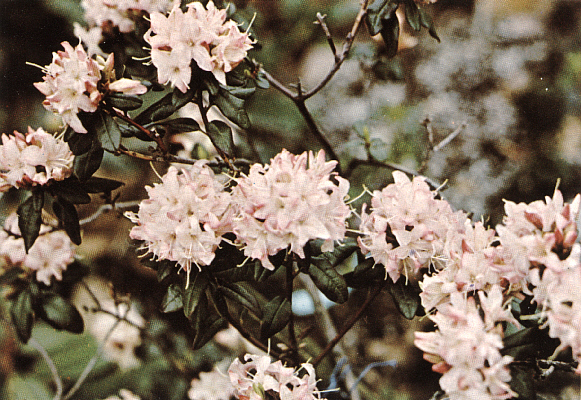QBARS - v31n3 R. racemosum 59717 (Rock #11403)
R. racemosum 59717 (Rock #11403)
by Ray and Jane Goodrich, Vienna, Va.

|
|
R. racemosum
59717 Rock #11403
Photo by Dr. A. E. Kehr |
This is perhaps the hardiest form of R. racemosum and is sparingly grown on the East Coast. We find no mention of it in the literature of the past fifty yea years.
In 1923 Joseph F. Rock collected seed of this form at 11,500 ft. in a "big gulch" in the Lichiang Snow Range, Yunnan Province, China. He had seen the plant in flower in May and described it as "a shrub two feet, flowers rich deep rose red." Rock's collection number is 11403.1.
Joseph B. Gable received seed in May of 1924 under the U.S. Department of Agriculture Plant Introduction Number 59717. This number is not listed in the Royal Horticultural Society Rhododendron Species Handbook. Perhaps this lot of seed never reached Great Britain. Study of the U. S. D. A. Plant Introduction files indicates that 59717-Rock 11403. 1
Plants grown by Gable at Stewartstown, Pa., proved much hardier than other forms of racemosum . Bowers 2 regarded 59717 (Rock 11403) as hardy with slight protection even in Central New York State.
Gable used this Rock form of racemosum in his cross with R. carolinianum which produced 'Conestoga'. From the F2 generation came 'Mayflower'. Nearing planted open pollinated seed of 'Conestoga' to get 'Windbeam' and 'Wyanokie'. Hence Rock 11403 produced hardy and fertile progeny. In contrast, Gable's cross of another form of racemosum Rock 6827 (P. I. 56363) with carolinianum resulted in sterile seedlings which were earlier blooming and more liable to spring frosts. 3
R. racemosum , although one of the easier alpines to grow, requires a loose soil mixture with good drainage. Inadequate summer rainfall will necessitate watering. A retentive soil mixture is not advisable. Planted on a north facing slope with high shade racemosum will become very floriferous. If not dead headed the plant will exhaust itself from seed production. Free from any magenta tint, racemosum combines well with other colors. Its graceful plant habit and small foliage provide a good foil for the larger-leaf rhododendrons. Planted in masses racemosum can be spectacular.
Cuttings of Rock 11403 will be sent to the Rhododendron Species Foundation.
1. Field Notes, 1923-24 expedition, Joseph F. Rock
2. Bowers, C. G., Rhododendrons and Azaleas, Macmillan, 1960 (second edition).
3. Personal notebooks, Joseph B. Gable.
